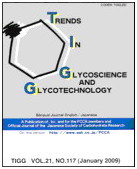All issues

Volume 21 (2009)
- Issue 122 Pages 309-
- Issue 121 Pages 255-
- Issue 120 Pages 197-
- Issue 119 Pages 131-
- Issue 118 Pages 49-
- Issue 117 Pages 1-
Volume 21, Issue 119
Displaying 1-5 of 5 articles from this issue
- |<
- <
- 1
- >
- >|
MINIREVIEW
-
Harry Schachter2009 Volume 21 Issue 119 Pages 131-148
Published: 2009
Released on J-STAGE: September 20, 2009
JOURNAL FREE ACCESSCaenorhabditis elegans makes about 150 individual N-glycan structures. This review discusses the synthesis and possible functions of the paucimannose N-glycans that are highly abundant in invertebrates but not in vertebrates. The complexity of the worm's N-glycans is due in part to a variety of unusual fucosylation reactions and the addition of phosphorylcholine. Phosphorylcholine has been recognized as a widespread antigenic determinant in many important disease-causing parasites. The synthesis of paucimannose N-glycans depends on the prior action of UDP-GlcNAc:α3-D-mannoside β1,2-N-acetylglucosaminyltransferase I (GnTI, encoded by Mgat1). There are three GnTI isoenzymes in the worm (GLY-12, GLY-13, GLY-14). Each GnTI isoenzyme has a distinct set of target proteins and a distinct role in the interaction of C.elegans with pathogenic bacteria. Identification of the protein substrates of GnTI in worms and elucidation of their functions may lead to a better understanding of the role of GnTI-dependent glycoproteins in the survival of both invertebrates and vertebrates.
View full abstractDownload PDF (744K) -
Shuhei Yamada, Shuji Mizumoto, Kazuyuki Sugahara2009 Volume 21 Issue 119 Pages 149-162
Published: 2009
Released on J-STAGE: September 20, 2009
JOURNAL FREE ACCESSAt the initial stage of cellular degradation of chondroitin sulfate/dermatan sulfate, an endo-type hydrolase is thought to degrade the long chain polysaccharides. Thus far, no endoglycosidases that are specific for chondroitin sulfate/dermatan sulfate have been reported; however, hyaluronan-degrading enzymes, hyaluronidases, are considered responsible. The nematode, Caenorhabditis elegans, is an ideal model for studies in a wide range of fundamental biological disciplines. Studies using the nematode have elucidated the biosynthetic mechanisms and functions of glycosaminoglycans. However, the catabolic pathways for glycosaminoglycans in C. elegans have not been investigated. Since C. elegans contains nonsulfated chondroitin but no hyaluronan, it is an ideal system for studying the hyaluronidase-independent catabolic mechanism of chondroitin/chondroitin sulfate. We have identified a chondroitin-specific endo-type hydrolase in C. elegans for the first time. The discovery of this enzyme suggests the presence of chondroitin sulfate/dermatan sulfate-specific endoglycosidases in mammalian systems.
View full abstractDownload PDF (1162K) -
Toshihiko Katoh, Hisashi Ashida, Kenji Yamamoto2009 Volume 21 Issue 119 Pages 163-177
Published: 2009
Released on J-STAGE: September 20, 2009
JOURNAL FREE ACCESSFree oligosaccharides (FOSs) found in the cytosol of eukaryotic cells are produced by the enzymatic degradation of dolichol-linked intermediates of N-linked glycosylation and/or by the action of cytosolic peptide:N-glycanases that are involved in the process of endoplasmic reticulum-associated degradation (ERAD) of glycoproteins. FOSs are subsequently trimmed by cytosolic endo-β-N-acetylglucosaminidase and α-mannosidase and then ultimately transferred to the lysosome for degradation into monosaccharides. In this minireview, we describe the formation, catabolism, and possible physiological roles of FOSs and present the results of our study on the structure and function of enzymes associated with the generation of FOSs in the nematode Caenorhabditis elegans.
View full abstractDownload PDF (962K) -
Souhei Mizuguchi, Katsufumi Dejima, Kazuya Nomura2009 Volume 21 Issue 119 Pages 179-191
Published: 2009
Released on J-STAGE: September 20, 2009
JOURNAL FREE ACCESSSulfation has become apparent as a critical biomolecule modification, where it plays a major role in homeostasis, development and morphogenesis in organisms ranging from bacteria to humans. Caenorhabditis elegans comprises most of the orthologs of mammalian sulfation-related genes, and it provides a powerful tool to study the various roles of sulfation at a single-cell level. Such a detailed analysis of sulfation is not available in other model organisms, such as Drosophila and mice. In this minireview, we list all the possible, bioinformatically selected, sulfation related genes in this nematode, and review the results of gene knockout experiments (RNAi and deletion mutagenesis) carried out in our laboratory, and by others. Further study using this unique and superior model organism will provide a unique opportunity to review the critical roles of sulfation in multicellular organisms.
View full abstractDownload PDF (643K)
GLYCOTOPICS
-
Azusa Yoneshige, Junko Matsuda2009 Volume 21 Issue 119 Pages 193-195
Published: 2009
Released on J-STAGE: September 20, 2009
JOURNAL FREE ACCESSDownload PDF (191K)
- |<
- <
- 1
- >
- >|